El Wire Light Sculpture
“Neon Space”
Project Description
In this project, I integrated the el wire with architectural elements with shape and structure to create a light sculpture. It consisted of 8 el wires that surround the inner corners of 8 acrylic panels. These acrylic panels differ in sizes and in the angle of position. The composition will perform a light show that mostly consisted of traveling light beams that come back and forth by turning each individual el wires on and off. The purpose of this project is to execute a zoom in and zoom out effect on the audience based on shapes and structures of the light. This will give the optical illusion that the light is traveling back and forth. The processing of coming up with such an idea is architectural based research. One that I found is on Copenhagen’s 2017 light and here is the link to the article that contains pictures and a video of the installation: Link. This installation consisted of many triangle panels that had lights going around the inner corners. When the audience stands in the middle it will give an illusion of depth. Later, I found a better representation that I will adapt for my intended project which the panels are at different angles.
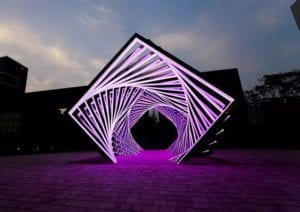
An example of a real architect that embodied shapes and light could be the vessel (honeycomb) in Hudson Yard, New York City. Not only does it look like a giant honeycomb, but from the top view, it looks like a hole with great depth.
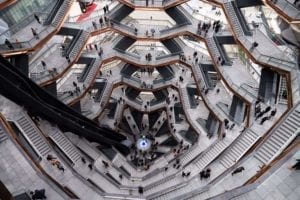
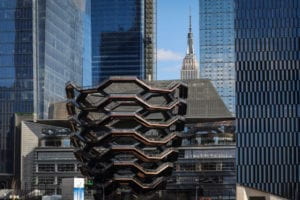
The structure of the vessel is the same on all levels but follow different sizes, increasing from bottom to top. At night, it shines warm orange light that why people called it the honeycomb along with the shape.
Perspective and Context
Maurice Merleau-Ponty writes “The real world is not this world of light and colour; it is not the fleshy spectacle which passes before my eyes. It consists, rather, of the waves and particles which science tells us lie behind these sensory illusions”. This quote says about our perception of the world around us is not the same as we perceive or thought it to be. It merely signals that is sent to our brain for interpretation. That’s why optical illusion art can create this motion in our brain to interpret even though it is flat or stationary. The project mimics a similar effect that is created based on the shape and size of the light beam through the embodiment of the panels. By turning it on and off in respect to time, it essentially will give a “zoom-in” illusion of traveling through space that the audience can immerse themselves into. Marleau says “What matters is the selection of episodes to be represented and, in each one, the choice of shots that will be featured in the film…” Many of the architectures today takes on this idea of optical illusion, using shapes and alter its size and through angle positioning like the vessel. The element of light enhances that illusion especially at night through a light composition and by emphasizing the shape and its outline. This project will allow us to physically immerse to a specific space and feel the change in light.
Development & Technical Implementation
The development all started by prototyping the structure that the light will be embodied. I’ve thought of different shapes such as square and triangle. I thought it doesn’t make a lot of difference so I picked squares. To visualize how it looks like, I used Google SketchUp to both visualize and make models that I will laser cut later. Initially, I thought of using 9 of these panels but had to cut down to 8 due to the limitation of ports of the el wire shield.
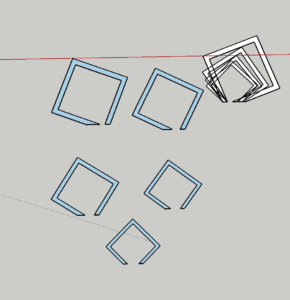
I realized I need a foundation perhaps, a box to put all my components. So I made a box that fits all the necessary components, again in Google Sketchup.
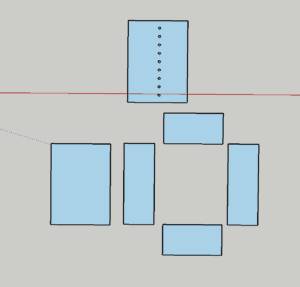
Before assembling them together, I have to get all the el wires connected to the shield as well as getting my composition finished. One problem that I faced is that the shield that I got from professor does not have a proper connection with the el wire. So I have to solder the connection with a head so that it can connect with the el wire. Below is a video that shows the process as well as the modification made to the Arduino shield.
After confirming that everything works, I began the process of light composition. For the light composition, I’ve created different case mostly traveling back and forth to create the optical illusion. For the code, I used milis() because I felt like this would fit my purpose better since it composes the light composition more precisely.
Lastly, I assembled the panels onto the foundation and the el wire by using super glue. In order to glue the el wire around the corner, I have measure where I should bend the el wire so that I can go around the sharp corner of the panel.
Presentation
The presentation was well and prepared. It was self-explanatory what this project is about. The audience understands what’s going to happen by the structure of my project. Overall, the presentation was good because the composition runs very smoothly. One thing that I could improve on is to tape the red light on the Arduino that shines out from the box and it is distracting. I wished I could add more panels and light to optimize the optical illusion effect on the audience. Maybe an enlarge of the overall scale could make the project more immersive to the audience.
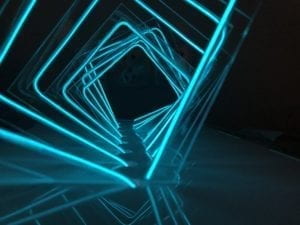
Conclusion
My proposal and plan for this project were carried out well and the trajectory was clear. I was able to manage the time well despite not having all the components in hand in the first place. I prioritize what is needed to finish first. For example, when I realized I couldn’t have my el wire done in the first hand, I shifted my plan to finish the model and the structure first. In this project, I learned how to make a model that is optimized for laser cutting which I’ve never directly done before by myself. In this project, I discovered the perception of shape and distance in term of light in the physical world rather than screen visual. If I had the resource and time, I would enlarge the scale of this project. I would try out different shape and positioning of the structure to see if there is any change in our perception of space.